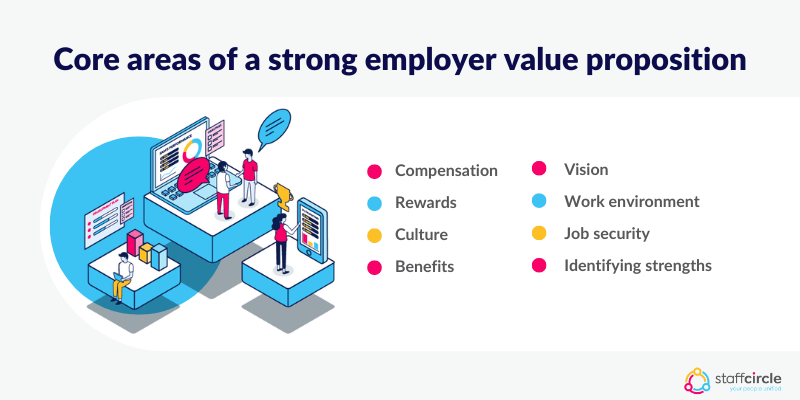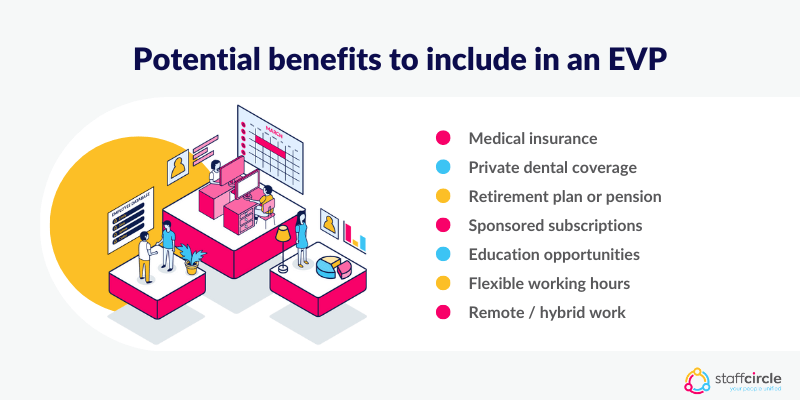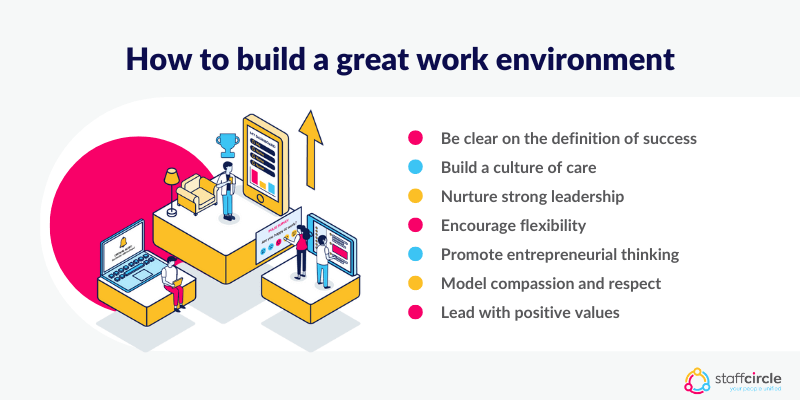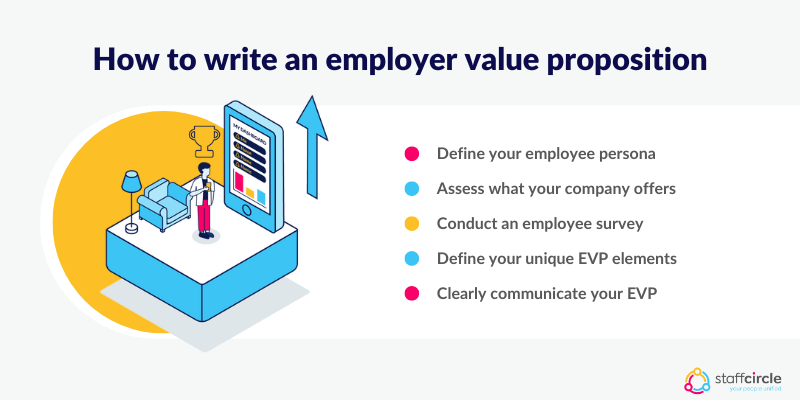In order to attract the top talent to your company, you’ll need a strong employer value proposition. A great EVP represents the best elements of a business, from the compensation received for a job well done to the working environment and attitude towards well-being
Read on and discover how an employer value proposition can help you attract and retain the very best employees for your company.
What is the importance of employer value proposition?
A strong employer value proposition is an essential feature for any company that wishes to attract the best talent. It encapsulates the company’s core value, culture, and shared vision, as well as the methods used to accomplish goals.
As Gallup points out in their article on employer value proposition, it expresses the sum total of what is most attractive about a given company.
“An organization’s employee value proposition (EVP) is the total value and benefits it promises to give current and prospective employees in exchange for performance. A clear and compelling EVP tells potential hires why an organization is preferable to the rest.”
This broad description can be broken down into a range of components, from financial remuneration and other intrinsic or extrinsic rewards to well-being and the work environment. All of these elements can help attract the right candidates when done right, making the company a beacon of creative thinking and professional development.
Download your free guide to improving employee retention
Discover the secrets to creating an irresistible workplace
The article from the Harvard Business Review, Make Your Employer Brand Stand Out in the Talent Marketplace, observes:
“When assessing a role or an organization, job seekers and employees inevitably ask themselves, “Is this work worth the effort?” When the answer is yes, that probably means you’ve got an EVP that lends itself to a strong employer brand. Employers can demand hard work, long hours, innovation, and top performance if that’s what it takes to progress toward organizational goals.”

The core areas of a strong employer value proposition include:
- Compensation
- Rewards
- Culture
- Benefits
- Vision
- Work environment
- Job security
- Identifying strengths
Let’s explore these various elements when designing an employer value proposition, as well as an example to place them in context.
What to consider when designing an EVP?
When implementing an employer branding framework to attract and retain top talent, there are several key areas to cover. Let’s take each of these in turn and explore how they can be best applied to an employer value proposition.
Compensation
Compensation covers salary raises, bonus payments, and other cash components that are offered to employees such as shares in the company. While financial reward isn’t enough on its own to attract the best employees, it should nevertheless be fair and competitive.
Any bonus structures offered should be clearly outlined in company documentation, and distributed uniformly throughout teams and departments. For additional transparency, business leaders can disclose the details on performance targets and the success rate of the company.
Performance appraisals should also be conducted regularly, with many of the leading corporations dropping annual appraisals in favour of monthly and quarterly reviews. These help managers and team leaders create more accurate assessments of performance and make better calls when it comes to compensation.
Rewards
Other types of rewards, some arguably more significant than the financial kind, should also be part of a company’s employer value proposition. This can include intrinsic rewards such as those found in companies with a culture of recognition.
Recognition programs encourage employees to model recognition through the celebration of individual and team successes. Awards can be given for a range of activities, from exceeding the month’s targets and producing above quota to embodying the company’s core values and serving as a brand ambassador.
Paying for training opportunities, holding employee appreciation events, and giving staff time off are other ways rewards can be used to enhance a company’s appeal.
Culture
The best companies excel because their employees are great cultural fits. They share the values, work ethic, and ambitions of the company at large, and as a result, are more committed to working hard and seeing it succeed.
Great cultures are defined not in terms of what the company does, but the way it does it. These values are often expressed in simple terms, for instance with Apple’s Think Differently slogan, which captured the essence of their innovative approach to design.
Business leaders can strengthen their culture and brand identity by using culture feedback tools found in performance management software. These mechanisms allow leaders to assess the strength of their employer value proposition through surveys and other feedback systems.
Over time, these insights can be tracked and analysed so that the culture can be updated to reflect the best elements of the workforce. At the same time, dashboards and reports hone in on the key drivers of culture and engagement for employees.
Benefits
In addition to financial rewards and other intrinsic incentives, a great employer value proposition should include a list of potential benefits employees receive. These benefits can include:
- Medical insurance and access to an occupational health nurse
- Free private dental coverage
- Payments into a retirement plan or pension
- Sponsored subscriptions, for instance to trade-related journals and other resources
- Education opportunities, including providing access to courses, online training, and university degree placements
- Flexible working hours
- The opportunity to work remotely or as part of a hybrid working arrangement
Again, such benefits should be accessed on a fair basis for all employees. They should also be clearly communicated so that employees are aware they can take advantage of these benefits. This can be through the company’s handbook, as well as being made available on the company forum.

When welcoming new members of staff to the company, they should be made aware of all benefits available to them as part of the onboarding process.
Vision
A company’s vision is closely related to its culture. With vision, employees can see a clear collective goal and understand what is expected of them to achieve it. This relates to those ambitious stretch goals that help businesses transcend the competition and deliver a truly impressive product or service.
An effective employer value proposition should show an appreciation for the need to align a company’s vision with that of the employee. When employees feel that their purpose is aligned with the company’s, they are motivated to go the extra mile. This motivation in turn helps to transform a greater number of employees into valuable A-players.
Work environment
All employees expect to enter a safe and healthy work environment when they come into the office. But a great work environment is about a lot more than how clean it is or if it lives up to industry safety standards. It’s about the atmosphere in which people work fostering collaborative employees capable of creative thinking.

A great work environment is also one where well-being is important, something which is becoming increasingly important in the post-pandemic world. Employers can build such work environments by:
- Being clear on their definition of success
- Building a culture of care in which people appreciate their value
- Nurturing strong leadership with an open door policy and high levels of engagement
- Encouraging flexibility to allow people to work hard when they’re at their best
- Promoting entrepreneurial thinking that encourages free thinking and creativity
- Modeling compassion and respect to help employees overcome adversities
- Leading with positive values such as an ethical approach to success
When these values of a great work environment are implemented, the best candidates for a role will be keen to join the team and contribute great work.
Job security
One of the driving factors behind low feelings of well-being and satisfaction among employees is poor job security. This can drive feelings of low self-esteem, foster a lack of meaning, and in worst-case scenarios lead to depression and other negative impacts on mental health.
A healthy sense of job security means employees are not afraid of unexpected layoffs or other economic downfalls that might affect their employment. Employees who feel secure in their role feel valued and recognised as human beings.
This results in lower levels of stress, anxiety, and other emotional disorders that impact performance. Burnout and anger are also avoided, leading to overall healthier employees who are happy and productive. While some people prefer to work in the gig economy, for many job security is essential.
When employees are secure in their roles, they can embrace opportunities for developing new skills. By building their talent stack, they can establish a sense of purpose and clarity at work.
Identifying Strengths
Business leaders and HR managers who understand the characteristics of high performing teams are better equipped to make the best hiring and promotion decisions.
Employer Value Proposition Example: How Do You Write An EVP?
Writing an employer value proposition is easy, provided you follow the basic principles and cover the necessary information. It should be clearly laid out and written in plain language so that potential employees understand the core reasons why they should work for your company.
There are 5 main steps to take when writing an employer value proposition.
These are:
1. Defining your employee persona
During this phase of the process, consider the kind of employee you’re trying to attract to the company. What are the skill sets and experience required for the roles? Are these roles creative or do they require strict adherence to specific processes?
This definition should include all the knowledge, capabilities, attitudes, and behaviours you expect from prospective employees. This will help ensure they are a good fit for the company and likely to settle into the workflow without any issues.
2. Assessing what it is your company offers
In this section, decide what perks, benefits, and other enticing rewards you offer as a company. This means outlining compensation paid for work, as well as raises and promotions so that new employees know what to expect.
It also includes details on the range of benefits you offer, including health insurance, childcare, and family support, paid time off, and company well-being initiatives.

3. Conducting a survey of your employees
When putting together an employer value proposition, you can involve your current employees to make sure you’ve covered everything important to the workforce. Existing staff have a clear idea of what it is they love about working at the company, as well as what they’d like to improve. Getting their feedback not only helps with writing an EVP, it also helps business leaders to brainstorm meaningful changes.
Conduct employee surveys, asking:
- What do they like or dislike about the company
- What best motivates them to deliver their best work
- In what ways do managers help facilitate a productive day
- What improvements they suggest the company implements
- How the company can best facilitate their professional development
4. Defining your unique employer value proposition elements
Once this information has been gathered, it’s time to define your unique employer value proposition. This means pinning down precisely the various advantages new employees will enjoy should they choose to work for the business. These elements should encompass a combination of work, rewards, people, opportunities, and the environment.
5. Clearly communicating your employer value proposition
Finally, once everything has been clarified, it’s time to write down your employer value proposition. This should be crafted to deliver a strong, concise statement, inspiring potential candidates to seek out more information about the role. Generic slogans and business-speak should be avoided, focusing on what sets the company apart from the competition.
Summary
A great employer value proposition is a calling card for the best aspects of a company. It can worl to attract the best and the brightest, letting them know what to expect when taking on a role. By monitoring employee satisfaction through employee analytics reports, a strong employer value proposition can reflect the optimal experience the company offers.






